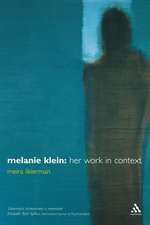What is this Professor Freud Like?: A Diary of an Analysis with Historical Comments: The History of Psychoanalysis Series
Autor Anna Koellreuteren Limba Engleză Paperback – 14 dec 2016
Din seria The History of Psychoanalysis Series
- 5%
 Preț: 218.86 lei
Preț: 218.86 lei -
 Preț: 245.02 lei
Preț: 245.02 lei - 5%
 Preț: 359.59 lei
Preț: 359.59 lei -
 Preț: 242.15 lei
Preț: 242.15 lei - 5%
 Preț: 273.68 lei
Preț: 273.68 lei - 5%
 Preț: 181.20 lei
Preț: 181.20 lei - 5%
 Preț: 273.92 lei
Preț: 273.92 lei -
 Preț: 286.69 lei
Preț: 286.69 lei - 5%
 Preț: 223.55 lei
Preț: 223.55 lei - 5%
 Preț: 221.55 lei
Preț: 221.55 lei -
 Preț: 244.87 lei
Preț: 244.87 lei -
 Preț: 257.70 lei
Preț: 257.70 lei - 5%
 Preț: 1095.75 lei
Preț: 1095.75 lei - 11%
 Preț: 822.19 lei
Preț: 822.19 lei - 15%
 Preț: 303.12 lei
Preț: 303.12 lei - 18%
 Preț: 818.74 lei
Preț: 818.74 lei - 5%
 Preț: 373.22 lei
Preț: 373.22 lei - 5%
 Preț: 290.05 lei
Preț: 290.05 lei - 18%
 Preț: 815.17 lei
Preț: 815.17 lei - 17%
 Preț: 214.54 lei
Preț: 214.54 lei - 5%
 Preț: 389.31 lei
Preț: 389.31 lei - 20%
 Preț: 221.14 lei
Preț: 221.14 lei - 5%
 Preț: 287.51 lei
Preț: 287.51 lei - 5%
 Preț: 333.03 lei
Preț: 333.03 lei - 18%
 Preț: 815.79 lei
Preț: 815.79 lei - 22%
 Preț: 178.37 lei
Preț: 178.37 lei - 18%
 Preț: 818.15 lei
Preț: 818.15 lei - 18%
 Preț: 815.57 lei
Preț: 815.57 lei - 5%
 Preț: 217.00 lei
Preț: 217.00 lei - 18%
 Preț: 815.17 lei
Preț: 815.17 lei - 18%
 Preț: 816.76 lei
Preț: 816.76 lei - 5%
 Preț: 218.84 lei
Preț: 218.84 lei - 5%
 Preț: 305.21 lei
Preț: 305.21 lei - 16%
 Preț: 216.70 lei
Preț: 216.70 lei - 5%
 Preț: 1099.95 lei
Preț: 1099.95 lei
Preț: 148.72 lei
Preț vechi: 190.98 lei
-22% Nou
Puncte Express: 223
Preț estimativ în valută:
28.46€ • 29.54$ • 23.73£
28.46€ • 29.54$ • 23.73£
Carte tipărită la comandă
Livrare economică 22 martie-05 aprilie
Preluare comenzi: 021 569.72.76
Specificații
ISBN-13: 9781782204145
ISBN-10: 1782204148
Pagini: 140
Dimensiuni: 152 x 229 mm
Greutate: 0.25 kg
Ediția:1
Editura: Taylor & Francis
Colecția Routledge
Seria The History of Psychoanalysis Series
Locul publicării:Oxford, United Kingdom
ISBN-10: 1782204148
Pagini: 140
Dimensiuni: 152 x 229 mm
Greutate: 0.25 kg
Ediția:1
Editura: Taylor & Francis
Colecția Routledge
Seria The History of Psychoanalysis Series
Locul publicării:Oxford, United Kingdom
Public țintă
Professional Practice & DevelopmentCuprins
Series Editor's Foreword , Introduction , Diary of an analysis, April 1921 , Illustrations , Being analysed by Freud in 1921—notes about the analytic process , Prof. Freud calls for tolerance!— Dashes that moved the couch and politics , Freud the analyst and therapist , Notes and questions for Freud and Ms Guggenbühl talking about the G case study
Descriere
In 1921, a young female doctor started analysis with Sigmund Freud. In a diary, she recorded what moved her. The present volume not only contains a full translation of these records, but also collects four essays by two psychoanalysts and two analytical historians who take their cue from the young doctor's notes to think about Freud.
















